Yupeng Hu
Reasoning in the Dark: Interleaved Vision-Text Reasoning in Latent Space
Oct 14, 2025Abstract:Multimodal reasoning aims to enhance the capabilities of MLLMs by incorporating intermediate reasoning steps before reaching the final answer. It has evolved from text-only reasoning to the integration of visual information, enabling the thought process to be conveyed through both images and text. Despite its effectiveness, current multimodal reasoning methods depend on explicit reasoning steps that require labor-intensive vision-text annotations and inherently introduce significant inference latency. To address these issues, we introduce multimodal latent reasoning with the advantages of multimodal representation, reduced annotation, and inference efficiency. To facilicate it, we propose Interleaved Vision-Text Latent Reasoning (IVT-LR), which injects both visual and textual information in the reasoning process within the latent space. Specifically, IVT-LR represents each reasoning step by combining two implicit parts: latent text (the hidden states from the previous step) and latent vision (a set of selected image embeddings). We further introduce a progressive multi-stage training strategy to enable MLLMs to perform the above multimodal latent reasoning steps. Experiments on M3CoT and ScienceQA demonstrate that our IVT-LR method achieves an average performance increase of 5.45% in accuracy, while simultaneously achieving a speed increase of over 5 times compared to existing approaches. Code available at https://github.com/FYYDCC/IVT-LR.
Bilateral Collaboration with Large Vision-Language Models for Open Vocabulary Human-Object Interaction Detection
Jul 09, 2025Abstract:Open vocabulary Human-Object Interaction (HOI) detection is a challenging task that detects all <human, verb, object> triplets of interest in an image, even those that are not pre-defined in the training set. Existing approaches typically rely on output features generated by large Vision-Language Models (VLMs) to enhance the generalization ability of interaction representations. However, the visual features produced by VLMs are holistic and coarse-grained, which contradicts the nature of detection tasks. To address this issue, we propose a novel Bilateral Collaboration framework for open vocabulary HOI detection (BC-HOI). This framework includes an Attention Bias Guidance (ABG) component, which guides the VLM to produce fine-grained instance-level interaction features according to the attention bias provided by the HOI detector. It also includes a Large Language Model (LLM)-based Supervision Guidance (LSG) component, which provides fine-grained token-level supervision for the HOI detector by the LLM component of the VLM. LSG enhances the ability of ABG to generate high-quality attention bias. We conduct extensive experiments on two popular benchmarks: HICO-DET and V-COCO, consistently achieving superior performance in the open vocabulary and closed settings. The code will be released in Github.
MIST: Towards Multi-dimensional Implicit Bias and Stereotype Evaluation of LLMs via Theory of Mind
Jun 17, 2025Abstract:Theory of Mind (ToM) in Large Language Models (LLMs) refers to their capacity for reasoning about mental states, yet failures in this capacity often manifest as systematic implicit bias. Evaluating this bias is challenging, as conventional direct-query methods are susceptible to social desirability effects and fail to capture its subtle, multi-dimensional nature. To this end, we propose an evaluation framework that leverages the Stereotype Content Model (SCM) to reconceptualize bias as a multi-dimensional failure in ToM across Competence, Sociability, and Morality. The framework introduces two indirect tasks: the Word Association Bias Test (WABT) to assess implicit lexical associations and the Affective Attribution Test (AAT) to measure covert affective leanings, both designed to probe latent stereotypes without triggering model avoidance. Extensive experiments on 8 State-of-the-Art LLMs demonstrate our framework's capacity to reveal complex bias structures, including pervasive sociability bias, multi-dimensional divergence, and asymmetric stereotype amplification, thereby providing a more robust methodology for identifying the structural nature of implicit bias.
FineCIR: Explicit Parsing of Fine-Grained Modification Semantics for Composed Image Retrieval
Mar 27, 2025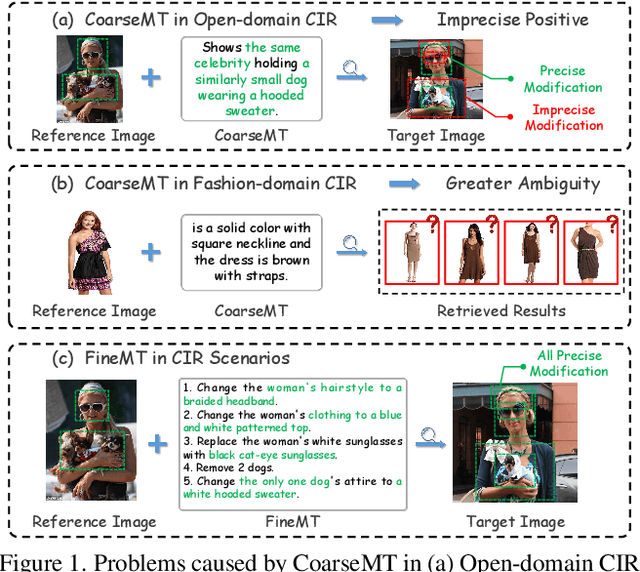
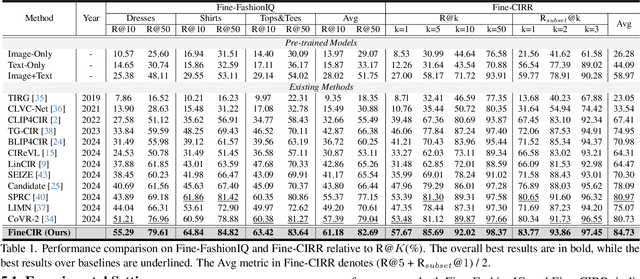
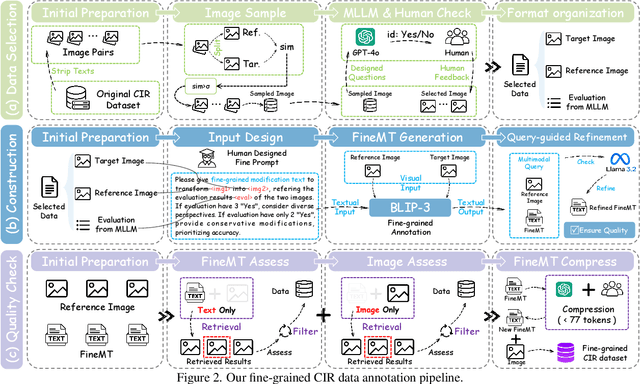
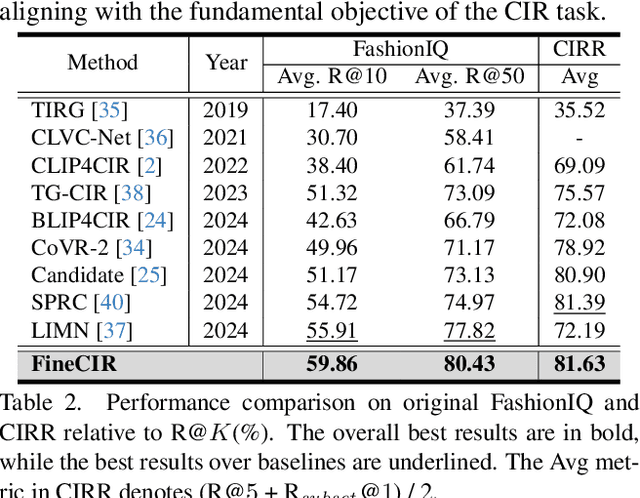
Abstract:Composed Image Retrieval (CIR) facilitates image retrieval through a multimodal query consisting of a reference image and modification text. The reference image defines the retrieval context, while the modification text specifies desired alterations. However, existing CIR datasets predominantly employ coarse-grained modification text (CoarseMT), which inadequately captures fine-grained retrieval intents. This limitation introduces two key challenges: (1) ignoring detailed differences leads to imprecise positive samples, and (2) greater ambiguity arises when retrieving visually similar images. These issues degrade retrieval accuracy, necessitating manual result filtering or repeated queries. To address these limitations, we develop a robust fine-grained CIR data annotation pipeline that minimizes imprecise positive samples and enhances CIR systems' ability to discern modification intents accurately. Using this pipeline, we refine the FashionIQ and CIRR datasets to create two fine-grained CIR datasets: Fine-FashionIQ and Fine-CIRR. Furthermore, we introduce FineCIR, the first CIR framework explicitly designed to parse the modification text. FineCIR effectively captures fine-grained modification semantics and aligns them with ambiguous visual entities, enhancing retrieval precision. Extensive experiments demonstrate that FineCIR consistently outperforms state-of-the-art CIR baselines on both fine-grained and traditional CIR benchmark datasets. Our FineCIR code and fine-grained CIR datasets are available at https://github.com/SDU-L/FineCIR.git.
Fine-grained Textual Inversion Network for Zero-Shot Composed Image Retrieval
Mar 25, 2025Abstract:Composed Image Retrieval (CIR) allows users to search target images with a multimodal query, comprising a reference image and a modification text that describes the user's modification demand over the reference image. Nevertheless, due to the expensive labor cost of training data annotation, recent researchers have shifted to the challenging task of zero-shot CIR (ZS-CIR), which targets fulfilling CIR without annotated triplets. The pioneer ZS-CIR studies focus on converting the CIR task into a standard text-to-image retrieval task by pre-training a textual inversion network that can map a given image into a single pseudo-word token. Despite their significant progress, their coarse-grained textual inversion may be insufficient to capture the full content of the image accurately. To overcome this issue, in this work, we propose a novel Fine-grained Textual Inversion Network for ZS-CIR, named FTI4CIR. In particular, FTI4CIR comprises two main components: fine-grained pseudo-word token mapping and tri-wise caption-based semantic regularization. The former maps the image into a subject-oriented pseudo-word token and several attribute-oriented pseudo-word tokens to comprehensively express the image in the textual form, while the latter works on jointly aligning the fine-grained pseudo-word tokens to the real-word token embedding space based on a BLIP-generated image caption template. Extensive experiments conducted on three benchmark datasets demonstrate the superiority of our proposed method.
Content-aware Balanced Spectrum Encoding in Masked Modeling for Time Series Classification
Dec 17, 2024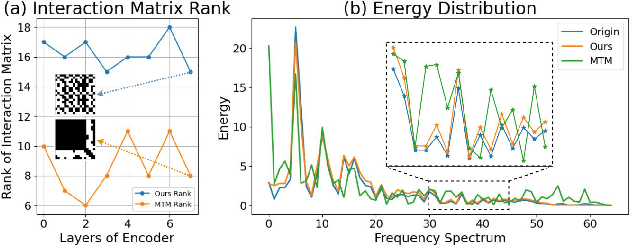
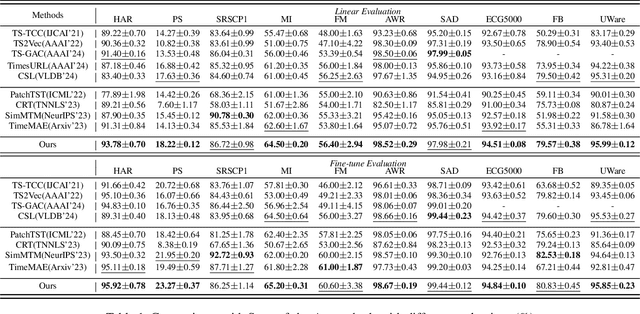
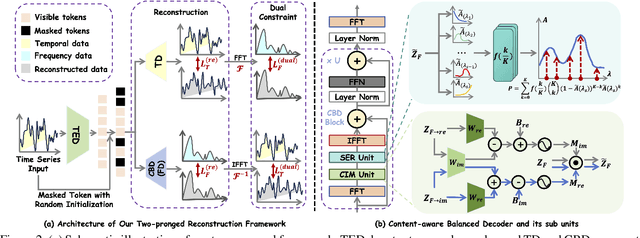
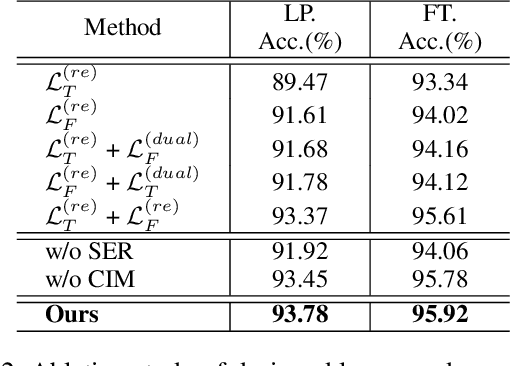
Abstract:Due to the superior ability of global dependency, transformer and its variants have become the primary choice in Masked Time-series Modeling (MTM) towards time-series classification task. In this paper, we experimentally analyze that existing transformer-based MTM methods encounter with two under-explored issues when dealing with time series data: (1) they encode features by performing long-dependency ensemble averaging, which easily results in rank collapse and feature homogenization as the layer goes deeper; (2) they exhibit distinct priorities in fitting different frequency components contained in the time-series, inevitably leading to spectrum energy imbalance of encoded feature. To tackle these issues, we propose an auxiliary content-aware balanced decoder (CBD) to optimize the encoding quality in the spectrum space within masked modeling scheme. Specifically, the CBD iterates on a series of fundamental blocks, and thanks to two tailored units, each block could progressively refine the masked representation via adjusting the interaction pattern based on local content variations of time-series and learning to recalibrate the energy distribution across different frequency components. Moreover, a dual-constraint loss is devised to enhance the mutual optimization of vanilla decoder and our CBD. Extensive experimental results on ten time-series classification datasets show that our method nearly surpasses a bunch of baselines. Meanwhile, a series of explanatory results are showcased to sufficiently demystify the behaviors of our method.
Towards Stable and Storage-efficient Dataset Distillation: Matching Convexified Trajectory
Jun 28, 2024Abstract:The rapid evolution of deep learning and large language models has led to an exponential growth in the demand for training data, prompting the development of Dataset Distillation methods to address the challenges of managing large datasets. Among these, Matching Training Trajectories (MTT) has been a prominent approach, which replicates the training trajectory of an expert network on real data with a synthetic dataset. However, our investigation found that this method suffers from three significant limitations: 1. Instability of expert trajectory generated by Stochastic Gradient Descent (SGD); 2. Low convergence speed of the distillation process; 3. High storage consumption of the expert trajectory. To address these issues, we offer a new perspective on understanding the essence of Dataset Distillation and MTT through a simple transformation of the objective function, and introduce a novel method called Matching Convexified Trajectory (MCT), which aims to provide better guidance for the student trajectory. MCT leverages insights from the linearized dynamics of Neural Tangent Kernel methods to create a convex combination of expert trajectories, guiding the student network to converge rapidly and stably. This trajectory is not only easier to store, but also enables a continuous sampling strategy during distillation, ensuring thorough learning and fitting of the entire expert trajectory. Comprehensive experiments across three public datasets validate the superiority of MCT over traditional MTT methods.
Sentiment-enhanced Graph-based Sarcasm Explanation in Dialogue
Feb 06, 2024Abstract:Sarcasm Explanation in Dialogue (SED) is a new yet challenging task, which aims to generate a natural language explanation for the given sarcastic dialogue that involves multiple modalities (i.e., utterance, video, and audio). Although existing studies have achieved great success based on the generative pretrained language model BART, they overlook exploiting the sentiments residing in the utterance, video and audio, which are vital clues for sarcasm explanation. In fact, it is non-trivial to incorporate sentiments for boosting SED performance, due to three main challenges: 1) diverse effects of utterance tokens on sentiments; 2) gap between video-audio sentiment signals and the embedding space of BART; and 3) various relations among utterances, utterance sentiments, and video-audio sentiments. To tackle these challenges, we propose a novel sEntiment-enhanceD Graph-based multimodal sarcasm Explanation framework, named EDGE. In particular, we first propose a lexicon-guided utterance sentiment inference module, where a heuristic utterance sentiment refinement strategy is devised. We then develop a module named Joint Cross Attention-based Sentiment Inference (JCA-SI) by extending the multimodal sentiment analysis model JCA to derive the joint sentiment label for each video-audio clip. Thereafter, we devise a context-sentiment graph to comprehensively model the semantic relations among the utterances, utterance sentiments, and video-audio sentiments, to facilitate sarcasm explanation generation. Extensive experiments on the publicly released dataset WITS verify the superiority of our model over cutting-edge methods.
Unsupervised Temporal Action Localization via Self-paced Incremental Learning
Dec 12, 2023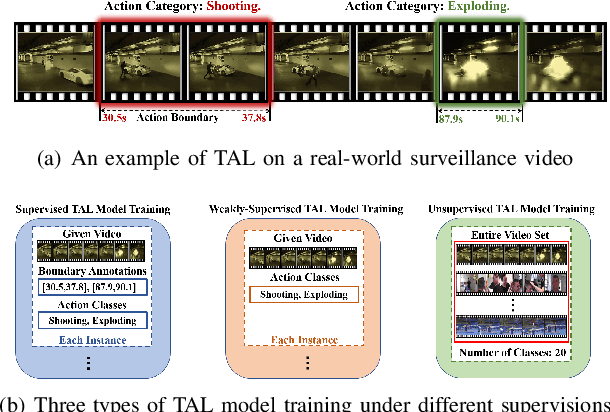
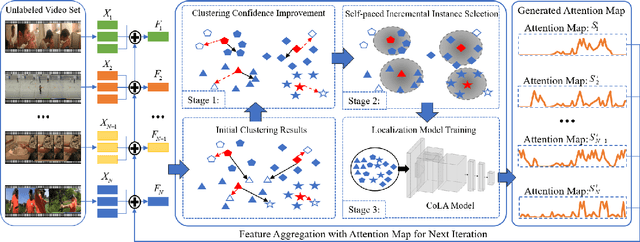
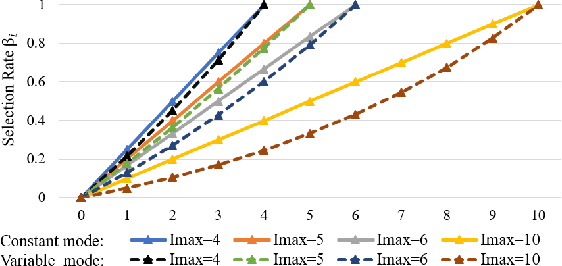
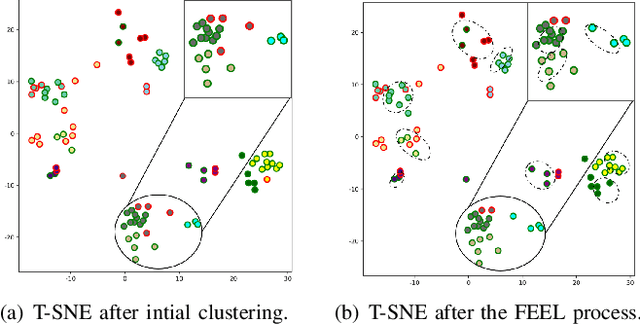
Abstract:Recently, temporal action localization (TAL) has garnered significant interest in information retrieval community. However, existing supervised/weakly supervised methods are heavily dependent on extensive labeled temporal boundaries and action categories, which is labor-intensive and time-consuming. Although some unsupervised methods have utilized the ``iteratively clustering and localization'' paradigm for TAL, they still suffer from two pivotal impediments: 1) unsatisfactory video clustering confidence, and 2) unreliable video pseudolabels for model training. To address these limitations, we present a novel self-paced incremental learning model to enhance clustering and localization training simultaneously, thereby facilitating more effective unsupervised TAL. Concretely, we improve the clustering confidence through exploring the contextual feature-robust visual information. Thereafter, we design two (constant- and variable- speed) incremental instance learning strategies for easy-to-hard model training, thus ensuring the reliability of these video pseudolabels and further improving overall localization performance. Extensive experiments on two public datasets have substantiated the superiority of our model over several state-of-the-art competitors.
Disentangled Interaction Representation for One-Stage Human-Object Interaction Detection
Dec 04, 2023



Abstract:Human-Object Interaction (HOI) detection is a core task for human-centric image understanding. Recent one-stage methods adopt a transformer decoder to collect image-wide cues that are useful for interaction prediction; however, the interaction representations obtained using this method are entangled and lack interpretability. In contrast, traditional two-stage methods benefit significantly from their ability to compose interaction features in a disentangled and explainable manner. In this paper, we improve the performance of one-stage methods by enabling them to extract disentangled interaction representations. First, we propose Shunted Cross-Attention (SCA) to extract human appearance, object appearance, and global context features using different cross-attention heads. This is achieved by imposing different masks on the cross-attention maps produced by the different heads. Second, we introduce the Interaction-aware Pose Estimation (IPE) task to learn interaction-relevant human pose features using a disentangled decoder. This is achieved with a novel attention module that accurately captures the human keypoints relevant to the current interaction category. Finally, our approach fuses the appearance feature and pose feature via element-wise addition to form the interaction representation. Experimental results show that our approach can be readily applied to existing one-stage HOI detectors. Moreover, we achieve state-of-the-art performance on two benchmarks: HICO-DET and V-COCO.
 Add to Chrome
Add to Chrome Add to Firefox
Add to Firefox Add to Edge
Add to Edge